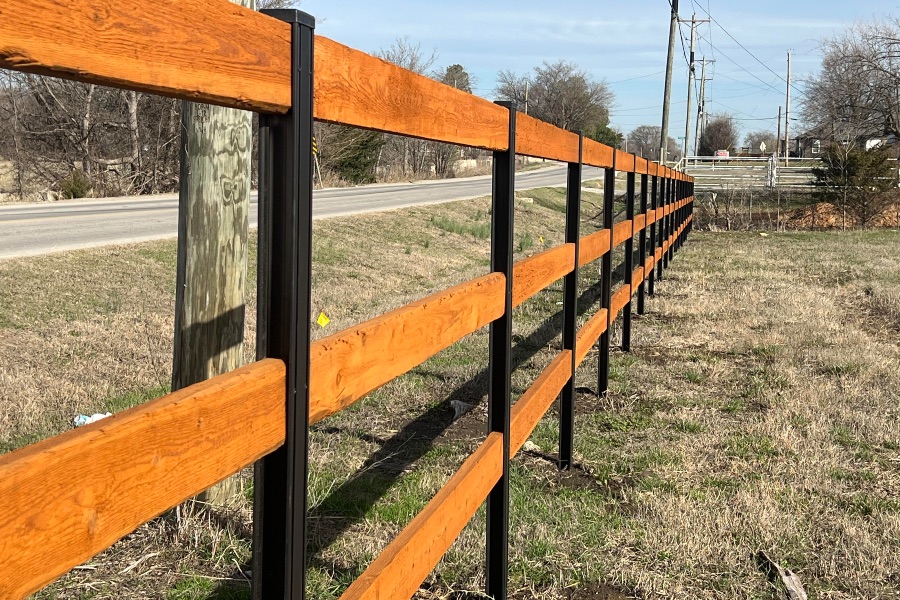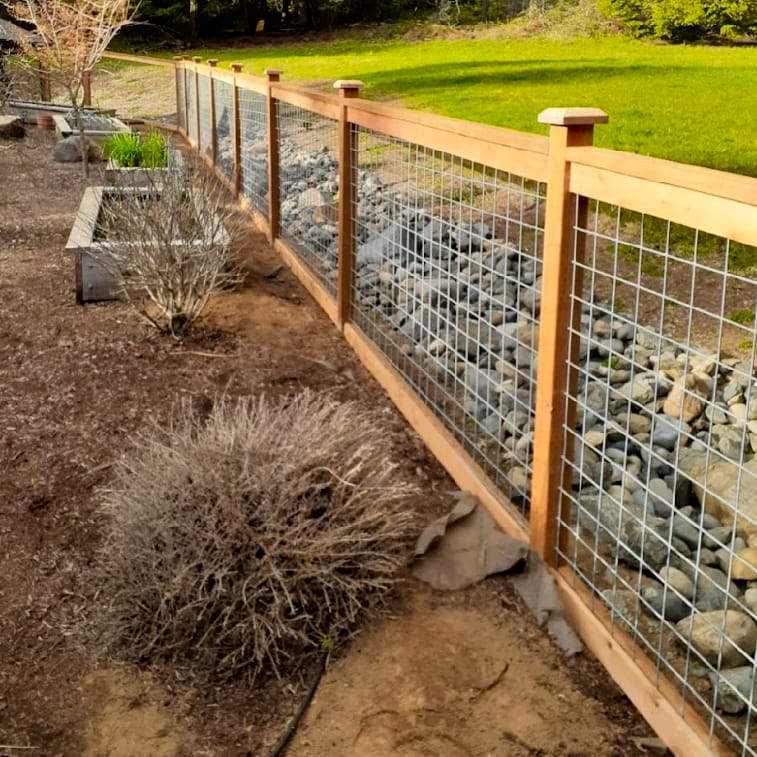All Categories
Featured
Fences play a crucial duty in supplying privacy, protection, and enhancing the aesthetic charm of your building. Nonetheless, continuous direct exposure to the components can bring about use and tear. From hefty rainfall and snow to intense sunlight and wind, weather-related damage is one of one of the most usual root causes of fence wear and tear. While you can't regulate the climate, there are several means to secure your fencing from the destructive effects of weather condition and ensure it lasts for many years to find.
Wooden Fencings: While wood fences are a classic choice, they are extremely vulnerable to moisture and pests. To make a timber fencing much more durable, decide for pressure-treated lumber, cedar, or redwood.
Plastic Fences: Vinyl fences are very resilient and call for little upkeep. They are resistant to fading, cracking, and bending, making them suitable for regions that experience extreme sun, rainfall, or cool weather condition. Plastic likewise won't rot or bring in bugs, providing lasting protection without the requirement for consistent upkeep.
Metal Fencings: Wrought iron and light weight aluminum fencings are superb selections for their stamina and resistance to wind and dampness. They are prone to rusting over time, particularly if exposed to regular rains or moisture. Select galvanized or powder-coated metal fences to reduce the threat of rust.
![]()
Composite Fences: Combining wood fibers and plastic, composite fences are resistant to decomposing, fading, and bug damage. They provide the appearance of timber with much less maintenance, making them a suitable option for locations with variable weather.
![]()
Wood Fencings: A great top quality wood sealant or tarnish is important to protect your fencing from the aspects. Be sure to reapply the finishing every pair of years to maintain your fence in leading condition.
Vinyl Fences: While plastic is low-maintenance, you can still secure it additionally by using a UV protectant. These finishings assist stop discoloration brought on by long term sun direct exposure. Furthermore, make use of vinyl-specific cleaners to maintain the surface area without discolorations or dust accumulation.
Metal Fences: To secure metal fencings from corrosion and deterioration, take into consideration using a rust-inhibiting guide adhered to by a safety paint created for outside use. Powder finishing supplies a resilient and durable surface that can stand up to extreme weather. if possible.
Wooden Fencings: Tidy your wooden fence with a stress washer or a soft fabric and light cleaning agent. Make certain to eliminate leaves, mold, and dust that can hold wetness versus the wood. Examine the fencing routinely for indications of rot, fractures, or insect infestations. Early discovery can avoid tiny issues from becoming costly repairs.
Vinyl Fences: Vinyl fences are simple to clean with soap and water. For tougher discolorations, you can utilize a mild bleach option or a plastic cleaner to bring back the fencing's look. Don't forget to examine for any splits that may allow water in, resulting in further damages.
Steel Fences: Tidy steel fences with a soft cloth to get rid of dust, corrosion, and dust. If you notice corrosion places, remove them immediately with a cable brush and deal with the area with a rust-resistant guide or paint to avoid it from spreading.
Wooden Fencings: When mounting wood fencing articles, see to it they are established deeply right into the ground, preferably below the frost line to prevent changing during freezing temperatures. Use concrete to safeguard the messages and prevent them from leaning or being rooted out by solid winds.
Steel Fences: For metal fencings, make sure that the articles are strongly secured in concrete. This is specifically essential in regions with constant tornados or hefty winds. You might additionally want to mount additional supporting to provide additional support versus wind anxiety.
In addition, extreme moisture from nearby plants can bring about mold and rot in wood fencings, so maintain greenery at a safe distance to allow for appropriate air flow and drainage.
Steel fencings need to be inspected for corrosion before the winter months season starts, and any influenced locations should be treated with rust-resistant items. Furthermore, applying a coat of paint or safety layer before the cold weather sets in can help shield your fencing from ice and snow damage.
![]()
Verdict. Shielding your fencing from weather-related damage requires a mix of proper material choice, routine maintenance, and positive treatment. Whether you have a wooden, plastic, steel, or composite fence, the best safety procedures can extend its life-span and keep its look. By complying with these straightforward yet reliable steps, you can guard your fencing versus the aspects and keep it looking wonderful for lots of years to find.
- Pick Weather-Resistant Materials. One of the most efficient methods to protect your fence is by picking the right material for your climate. Particular products are a lot more sturdy and much better fit to withstand certain climate problems.
Wooden Fencings: While wood fences are a classic choice, they are extremely vulnerable to moisture and pests. To make a timber fencing much more durable, decide for pressure-treated lumber, cedar, or redwood.
Plastic Fences: Vinyl fences are very resilient and call for little upkeep. They are resistant to fading, cracking, and bending, making them suitable for regions that experience extreme sun, rainfall, or cool weather condition. Plastic likewise won't rot or bring in bugs, providing lasting protection without the requirement for consistent upkeep.
Metal Fencings: Wrought iron and light weight aluminum fencings are superb selections for their stamina and resistance to wind and dampness. They are prone to rusting over time, particularly if exposed to regular rains or moisture. Select galvanized or powder-coated metal fences to reduce the threat of rust.

Composite Fences: Combining wood fibers and plastic, composite fences are resistant to decomposing, fading, and bug damage. They provide the appearance of timber with much less maintenance, making them a suitable option for locations with variable weather.
- Apply Protective Coatings. Regardless of the product, applying protective finishings is vital in extending the life of your fencing. Coatings create an obstacle that shields your fencing from moisture, UV rays, and various other ecological stress factors.

Wood Fencings: A great top quality wood sealant or tarnish is important to protect your fencing from the aspects. Be sure to reapply the finishing every pair of years to maintain your fence in leading condition.
Vinyl Fences: While plastic is low-maintenance, you can still secure it additionally by using a UV protectant. These finishings assist stop discoloration brought on by long term sun direct exposure. Furthermore, make use of vinyl-specific cleaners to maintain the surface area without discolorations or dust accumulation.
Metal Fences: To secure metal fencings from corrosion and deterioration, take into consideration using a rust-inhibiting guide adhered to by a safety paint created for outside use. Powder finishing supplies a resilient and durable surface that can stand up to extreme weather. if possible.
- Regular Cleaning and Assessments. Proper cleansing and regular assessments are important to keeping the honesty of your fencing. Build-up of mold and mildew, dust, and debris can trap wetness versus your fence and cause lasting damage.
Wooden Fencings: Tidy your wooden fence with a stress washer or a soft fabric and light cleaning agent. Make certain to eliminate leaves, mold, and dust that can hold wetness versus the wood. Examine the fencing routinely for indications of rot, fractures, or insect infestations. Early discovery can avoid tiny issues from becoming costly repairs.
Vinyl Fences: Vinyl fences are simple to clean with soap and water. For tougher discolorations, you can utilize a mild bleach option or a plastic cleaner to bring back the fencing's look. Don't forget to examine for any splits that may allow water in, resulting in further damages.
Steel Fences: Tidy steel fences with a soft cloth to get rid of dust, corrosion, and dust. If you notice corrosion places, remove them immediately with a cable brush and deal with the area with a rust-resistant guide or paint to avoid it from spreading.
- Reinforce Your Fence with Proper Installment. Appropriate installment is one of one of the most effective methods to avoid weather-related damages. A fencing that is inadequately mounted is more likely to collapse or experience damages during tornados.
Wooden Fencings: When mounting wood fencing articles, see to it they are established deeply right into the ground, preferably below the frost line to prevent changing during freezing temperatures. Use concrete to safeguard the messages and prevent them from leaning or being rooted out by solid winds.
Steel Fences: For metal fencings, make sure that the articles are strongly secured in concrete. This is specifically essential in regions with constant tornados or hefty winds. You might additionally want to mount additional supporting to provide additional support versus wind anxiety.
- Trim Trees and Shrubs Near Your Fencing. Thick trees and shrubs can trigger substantial damage to your fencing, particularly during heavy storms or high winds. Tree branches can scrape versus the fence, triggering scrapes, and their origins can undercut the articles. Keep greenery trimmed and make certain that tree branches are not leaning on or near the fence.
In addition, extreme moisture from nearby plants can bring about mold and rot in wood fencings, so maintain greenery at a safe distance to allow for appropriate air flow and drainage.
- Winterize Your Fence. Take added safety measures to safeguard your fence from freezing temperatures, snow, and ice if you live in an area with rough winters. For wooden fencings, make certain the base of the articles is raised over ground level to stay clear of water accumulation, which can ice up and break the timber. Think about using a wetness obstacle around the base of the posts to keep them completely dry during the winter season.
Steel fencings need to be inspected for corrosion before the winter months season starts, and any influenced locations should be treated with rust-resistant items. Furthermore, applying a coat of paint or safety layer before the cold weather sets in can help shield your fencing from ice and snow damage.
- Post-Storm Services. Tornados can cause immediate damage to your fencing, consisting of dropped branches, damaged blog posts, or dislodged panels. If your fencing has actually been seriously harmed, it's a good concept to seek advice from a professional for fixings to guarantee it continues to be structurally sound.

Verdict. Shielding your fencing from weather-related damage requires a mix of proper material choice, routine maintenance, and positive treatment. Whether you have a wooden, plastic, steel, or composite fence, the best safety procedures can extend its life-span and keep its look. By complying with these straightforward yet reliable steps, you can guard your fencing versus the aspects and keep it looking wonderful for lots of years to find.
Latest Posts
Professional Auto Care for All Cars & Trucks: Your Trusted Repair Hub in Montclare
Published Apr 19, 25
2 min read
Affordable Car Services: Top-Quality Repairs Without Breaking the Bank
Published Apr 19, 25
2 min read
Emergency Roof Covering Repair Work-- Stopping Leaks in Their Tracks
Published Apr 19, 25
1 min read
More
Latest Posts
Professional Auto Care for All Cars & Trucks: Your Trusted Repair Hub in Montclare
Published Apr 19, 25
2 min read
Affordable Car Services: Top-Quality Repairs Without Breaking the Bank
Published Apr 19, 25
2 min read
Emergency Roof Covering Repair Work-- Stopping Leaks in Their Tracks
Published Apr 19, 25
1 min read